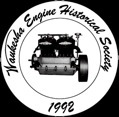The Motor Works - Part 2 (added June 2014)
First motor, Model A, designed to power boats
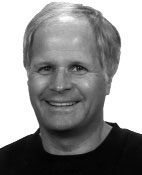 |
JOHN SCHOENKNECHT |
Company moves to new digs in 1909
The first motor
Horning and Ahrens set about designing and building the first motor, aptly named the Model A.
The men needed to build a prototype motor. It had to be designed from scratch. Every part needed to be designed and cast and then put together. The first engine cost $12,000, almost half the capitalization of the company. It was designed to be mounted on a boat used in Pewaukee Lake, but the owner of the boat, who bought the engine for $500, quickly resold it for more than he paid.
The company received more orders for motors – mostly from boat owners, but also car and truck builders.
In 1907, the design of the Model A was standardized and it went into production, along with a Model H.
The first large order received by Waukesha Motor was eventually refused. An Ohio oil and grease firm wanted a large quantity of motors, but proposed to pay for the motors with grease. The officers of the company knew they would have a ton of grease to get rid of, and declined the offer.
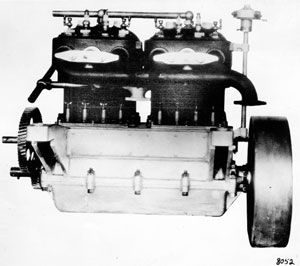 |
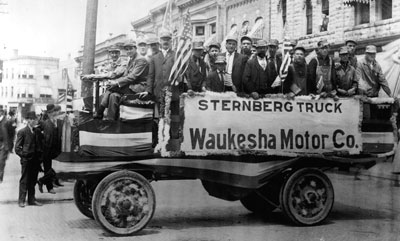 |
Photo from the Waukesha Engine Historical Society |
Freeman file photo |
| The first manufactured engine, the Model A, was designed for use on a boat. | This photo is believed to have been taken about 1908. It shows a Sternberg truck at the intersection of Grand Avenue and South Street with a Waukesha motor. On the truck, the third man from the left (slightly blurry) is Harry Horning. Fifth is Sam Perkins and ninth is Fred Ahrens |
As word of the worth of the engines spread, the fledgling company got a couple of orders for truck engines. This was a new field. Most of the truck assemblers were in the Midwest and in the East.
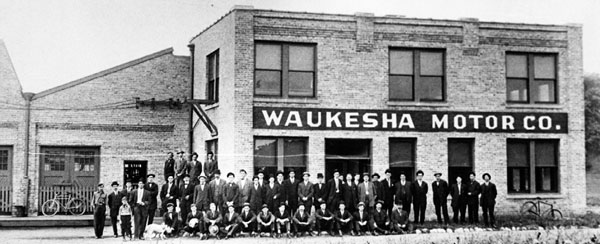 |
| Freeman file photo |
| Employees gather in front of the Waukesha Motor Co. about 1911. |
1908-1909: Growing, changing and moving
In 1908 an order was received for a motor for a Chicago Fire Department truck. It was controversial as one official in the Windy City complained that removing horses from the old fire wagons would take the glamor out of firefighting.
In February of 1908, a new board of directors was abruptly elected. Stebbins, the original money man, left the company. Samper Perkins, a longtime friend of the Horning family, was elected to the board as president.
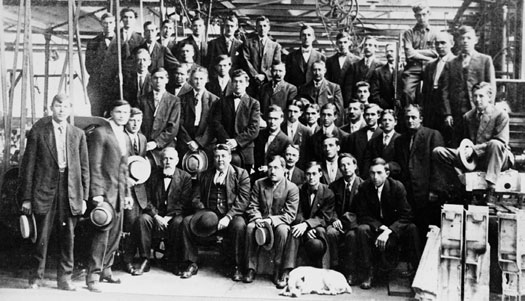 |
The staff of the Waukesha Motor Co. posed for this photo in 1910. Harry Horning, 29 years old, is front and center holding his straw hat. Sam Perkins is looking over Horning’s left shoulder. James Remington is fourth from the left in the top row. |
| Freeman file photo |
Samper Perkins
Perkins was born Jan. 27, 1862, in Stevens Point, to Martin and Sarah Perkins.
Martin was a cabinetmaker by trade. Martin and Sarah had a large family: Florence (1858), Victor (1860), Samper (1862), Eugene (1864), Matilda (1866), Isabell (1869), and Alfred (1872) were listed in the census records.
The 1880 census shows that Sam was in Waukesha, living with his mother, Sarah, sister Isabell, and brothers Eugene and Alfred.
According to Gib Koenig, “He lost no time in seeking work, and was hired by Bethesda Mineral Spring Co.
as a chore boy at its Dunbar Ave. bottling works. Eager to get better acquainted with the community, he became a clerk at the J. T. Mahoney Music Store but, lacking a talent for music, he soon shifted to the hardware store owned by J. G. Hart.”
According to Koenig, when Hart retired from the hardware business, Perkins borrowed money and purchased his store. Perkins enjoyed the hardware business, and he became acquainted with his biggest rival, Henry M. Horning, who owned arguably the village’s largest hardware store at 712 Clinton St.
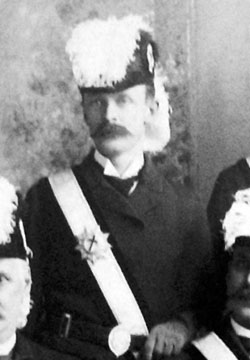 |
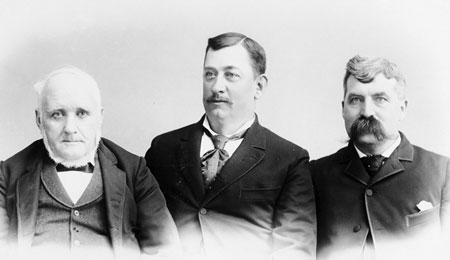 |
| Waukesha Masonic Lodge photo | Photo from the Waukesha County Museum |
| Samper A. Perkins in his Masonic uniform. | Conrad Haertl, center, with his assistants at the Register of Deeds Office. Haertl owned a boat with a temperamental motor. He asked Harry Horning and Fred Ahrens if they could get it to run smoothly. He later served as president of the company from 1909 to 1925. |
The 1892 and 1895 city directories show that Perkins was a salesman in Horning’s hardware store and lived at 604 Madison St. and later 107 East Ave. with the Horning family.
By 1899. the unmarried 38 year old Perkins was living with his widowed mother at 113 East Ave. He also owned the former Horning Hardware Store on Clinton Street.
A Feb. 2, 1902, Freeman article mentioned that Perkins had purchased the hardware company of Gaspar and Lyons. The article stated that he had previously been in business by himself and as a partner in Horning and Perkins and Perkins and Watson hardware stores.
The 1907 city directory showed that Perkins opened the Perkins Hardware Co. at 414-416 Main St. and 415-417 Broadway. He was in business with his younger brother Alfred.
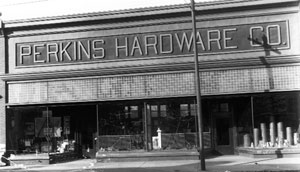 |
| Photo from the John Schoenknecht collection at the Waukesha County Museum |
| Perkins Hardware Store on Broadway. |
By 1910, Perkins was again renting a room at the home of the Horning family, 418 Hartwell Ave. Henry was 58, Sam was 47 and Harry was 28.
Perkins only served one year as president of the company, but his contribution during that year was crucial.
He realized that the company needed more capital to grow.
He found a group of backers in Flint, Mich., who were willing to invest in the company. Just before meeting with the group and discussing moving the company to Flint, a second group of Waukesha investors stepped forward. This group consisted of many local bankers, including Andrew Frame and Edward Estberg of the Waukesha National Bank and Charles Nelson of Milwaukee’s First Wisconsin National Bank. Others included Frank H. Putney, Conrad Haertel, Aaron S.
Putney and Charles Newbury.
According to the May 27, 1909, Freeman, two new seats were added to the board of directors as the company reorganized. Eventually Haertel, Estberg and Nelson joined the board. Fred Ahrens, one of the original members, was appointed as general superintendent. It is uncertain if he continued in this position. An article in the Oct. 17, 1912, Freeman stated that Ahrens, who had been operating a garage and repair shop, closed his business and was in charge of the assembling department at Waukesha Motor. Ahrens continued to work for the company, but eventually left Waukesha altogether.
According to the June 10, 1910, Freeman, Conrad Haertel, who owned profitable stores at 338 Broadway and 333 Main St., was elected president in place of Perkins. Perkins continued to serve as secretary-treasurer of the company, a position he held for the rest of his life.
Perkins was a frugal person and invested in other businesses and land deals. He became one of the city’s leading industrialists and benefactors.
Harry Horning was given the title of secretary and general manager of the company. He was 29 years old.
Inside look
When the company celebrated its 25th anniversary in 1931, James Remington recalled a few humorous incidents for the newsletter called Turbulence. His memories give a rare “inside look” at the early years. The following excerpt is from Michael J. Goc’s book “Facing Forward”:
“He (Remington) recalled how young Harry Horning rode a bicycle to and from work, how the daughter of company president Allan Stebbins would call the garage every day and, with a giggle in her voice, ask ‘Hello Jimmy, is this the motor works?’ and how, as low man on the corporate totem pole, Remington had to come in early, stoke the boiler, dust the desks, sweep the shop, and swab out Sam Perkins’ cuspidor. He also carried car batteries across town to be charged at Metal Structures and delivered drawings of new motors to the city engineer for blueprints. When a customer wanted to visit the ‘factory,’ Horning and Perkins did their best to schedule the tour after working hours. They would then collect as many coveralls and jackets as they could find and spread them at what appeared to be work stations around the shop so the sales prospect would think Waukesha Motor had not three or four but thirty people at work.”
New facility
The new board realized that the facility on North Street was too small for the growing company. They started a search for a new site and designed plans for a new factory. A search committee, headed by Charles Nelson, found a tract of land on the west side of the city along St.
Paul Avenue. The land was purchased for $3,000. It was an ideal spot because it was located near several railroads and there was plenty of room for expansion.
The new plant consisted of an office building with a second floor for storage. There was a large steel-framed working building that comprised the heart of the plant. The roof was of sawtooth construction with four bays of perpendicular windows, which lit the big interior work space. The buildings were made of concrete and steel. The power was supplied by the newly organized Waukesha Gas and Electric Co.
Early maps show that a new street, “Factory Street”was created. The street was located where Washington Avenue today meets St. Paul Avenue. Factory Street went from St. Paul Avenue south toward the river. It eventually became part of the complex.
In December 1909, the move was made. According to the book “Facing Forward,” “fifty workers moved into the new plant, which was reportedly designed to produce at least one thousand motors a year.”
The Dec. 2, 1909, Freeman gave an interesting description of the plant. There was a main drive shaft, run by electricity, to which various machines could be attached, or in some cases machines were hooked up directly to the electric lines.
“The machinery department, shipping, stock testing and tool departments are all located on the main floor of the building, which is as fine a machinery work shop as the country affords. The plant has a very industrious appearance with the piles of material laying about ready to be put through the different processes through which various parts constituting a complete four-cylinder motor are passed.”
(John Schoenknecht, a retired Waukesha art teacher and a local historian, is the author of “The Great Waukesha Springs Era: 1868 – 1918” and “From Prairieville to Waukesha.” He can be reached at thbolt@wi.rr.com.)
This article was originally published in the Wednesday, January 22, 2014 issue of The Freeman Waukesha County's newspaper.
Copyright © 2014 Waukesha Engine Historical Society, Inc. All rights reserved
